 Are you concerned when you see your child or teen daydreaming? According to Daniel Goleman, author of many books including his latest one, Focus: The Hidden Driver of Excellence, periodically letting your mind drift is actually good for you. It allows for creativity and rest that the brain doesn’t otherwise engage in. I recently read Focus and was struck by the importance of occasional attention wandering which Goleman refers to as “open awareness”. Usually, in our busy days, our brains spend most of the time purposefully assembling, managing and applying information. We engage in actions, behaviors and self-expression that require complex mental and physical processes. Attention is focused on a variety of situations, people and problems. This focus comes from interactions between the different parts of the brain. The lower brain works mostly out of our consciousness, checking sensory information and events in our environment. The mid-brain monitors and processes emotions. The frontal lobes (the prefrontal cortex) are often called ‘the thinking brain’. They manage executive functioning skills like planning, organizing, self-reflection and impulse control that push away distractions and point the mind to a single task or thought. The prefrontal cortex is the last part of the brain to finish developing (around age 25) and is specifically affected by having ADHD. Of course, attention is also affected by cultural norms, technology and trauma.
Are you concerned when you see your child or teen daydreaming? According to Daniel Goleman, author of many books including his latest one, Focus: The Hidden Driver of Excellence, periodically letting your mind drift is actually good for you. It allows for creativity and rest that the brain doesn’t otherwise engage in. I recently read Focus and was struck by the importance of occasional attention wandering which Goleman refers to as “open awareness”. Usually, in our busy days, our brains spend most of the time purposefully assembling, managing and applying information. We engage in actions, behaviors and self-expression that require complex mental and physical processes. Attention is focused on a variety of situations, people and problems. This focus comes from interactions between the different parts of the brain. The lower brain works mostly out of our consciousness, checking sensory information and events in our environment. The mid-brain monitors and processes emotions. The frontal lobes (the prefrontal cortex) are often called ‘the thinking brain’. They manage executive functioning skills like planning, organizing, self-reflection and impulse control that push away distractions and point the mind to a single task or thought. The prefrontal cortex is the last part of the brain to finish developing (around age 25) and is specifically affected by having ADHD. Of course, attention is also affected by cultural norms, technology and trauma.  We are bombarded by information every moment of every day. The constant stimulation creates what Goleman refers to as the ‘neural buzz” in our brains. This ‘buzz’ can easily interrupt us and overwhelm our capacity to manage our focus. People with ADHD/ADD are especially susceptible to these interruptions and benefit from the balance that occasional ‘zoning out’ provides. In fact, some scientists believe that daydreams might actually be time when innovative connections between new ideas are occurring. So, what does this mean for you and your child? Simply put, allow for some down time—time when the brain can free associate and take a break from the demands of technology, relationships, academics and performance. Try this: 1. Create technology-free time on a daily or weekly basis, depending on your child’s needs. Let your child use this time for whatever else he or she wants to do, including and especially nothing. Set limits for this time in advance. 2. Make a list of various activities for this time with your child or teen so you can avoid an argument when it arrives. 3. Participate with your child in this time, also refraining from technological interruptions. This way your child will take it seriously. Remember this is time for personal and family balance from the busy work the brain does all day long. Take a deep breath and enjoy the wandering!
We are bombarded by information every moment of every day. The constant stimulation creates what Goleman refers to as the ‘neural buzz” in our brains. This ‘buzz’ can easily interrupt us and overwhelm our capacity to manage our focus. People with ADHD/ADD are especially susceptible to these interruptions and benefit from the balance that occasional ‘zoning out’ provides. In fact, some scientists believe that daydreams might actually be time when innovative connections between new ideas are occurring. So, what does this mean for you and your child? Simply put, allow for some down time—time when the brain can free associate and take a break from the demands of technology, relationships, academics and performance. Try this: 1. Create technology-free time on a daily or weekly basis, depending on your child’s needs. Let your child use this time for whatever else he or she wants to do, including and especially nothing. Set limits for this time in advance. 2. Make a list of various activities for this time with your child or teen so you can avoid an argument when it arrives. 3. Participate with your child in this time, also refraining from technological interruptions. This way your child will take it seriously. Remember this is time for personal and family balance from the busy work the brain does all day long. Take a deep breath and enjoy the wandering!
Author: artefact_admin
Helping Teens Thrive in High School-Versan Educational Symposium
“Helping Teens Thrive in High School” Versan Educational Symposium, Kingston, Jamaica, 2014; Kingston Local Radio
WXOJ Valley Free Radio 103.3 FM Kickin’it with Rick Haggerty 38:02 “Who are teens and why do they act the way they do?”
Snow what?! Getting help with winter chores
 When it gets this cold and snowy, there is always extra work at home to do. How can you get your ADHD son or daughter to help you and not hold you back? Whether it’s shoveling snow, clearing off cars or carrying wood, parents need help from their children but often choose to do the chores themselves. Involving your child can require extra work for you (and sometimes extra irritation) resulting in less productivity. So, most likely, you would rather just head out alone. Doing a chore alone has its benefits for a parent: no hassling with a reluctant teen, no reminding a child to stay with the task at hand and no one asking twenty times “How much longer will this take?” This choice, however, is problematic for everyone in the family. You wind up being more tired and perhaps even resentful that you are working alone–again. Your children or teens don’t learn the skills associated with the chore. They also don’t gain the value of helping someone. Lastly, no one gets the satisfaction of completing something together.
When it gets this cold and snowy, there is always extra work at home to do. How can you get your ADHD son or daughter to help you and not hold you back? Whether it’s shoveling snow, clearing off cars or carrying wood, parents need help from their children but often choose to do the chores themselves. Involving your child can require extra work for you (and sometimes extra irritation) resulting in less productivity. So, most likely, you would rather just head out alone. Doing a chore alone has its benefits for a parent: no hassling with a reluctant teen, no reminding a child to stay with the task at hand and no one asking twenty times “How much longer will this take?” This choice, however, is problematic for everyone in the family. You wind up being more tired and perhaps even resentful that you are working alone–again. Your children or teens don’t learn the skills associated with the chore. They also don’t gain the value of helping someone. Lastly, no one gets the satisfaction of completing something together.  In order to create a win-win situation for everyone (the work is done jointly and correctly with minimal arguing), there have to be clear expectations about the tasks at hand. These simple guidelines need to be established before–way before you embark on the chore itself and will assist all of you in creating a successful experience: 1. In a calm moment that you set aside for a family conversation before the first snowflakes have fallen but after the temperature has already started to drop, brainstorm with your child or teen how you as a family want to approach the winter chores. Who wants to do what and for how long? What is the incentive that your child or teen needs to participate (help with a project that matters to him or her, an extra chunk of computer or television time, hot chocolate and a special baked treat, etc.)? What are the consequences for not participating or arguing while working? 2. Talk about obstacles that have impeded working together on winter chores in the past and strategize about how to deal with them if they re-occur this year. 3. Make an agreement about a time limit for the chore and stick with that. Discuss how you will keep track of time and how you will handle redirecting your child when he drifts off and slows down. Inject some fun into the task. Try doing something goofy like playing music she likes on her iPod out loud. Make snow angels. Play catch with snowballs. Build a fort or snowman. 4. If, at the end of the time period, there is still some work to do and your young assistant has run out of cooperation, patience and concentration, set him or her free and finish it yourself. (Of course, he or she can stay longer if desired.) Remember, that you are contributing to the development of his or her executive skills by planning, participating and sticking with tasks that have to be done but may not be much fun to do. Plus, you are building lifelong memories of doing chores with a parent (remember being outside in the cold when you were a child??). 5. Share a yummy hot chocolate, warm cider or steaming tea when you are done and marvel at your accomplishment. Maybe even play a game, watch a movie or read a book together! So, grab your gloves and shovels and get started. It’s a winter wonderland out there!
In order to create a win-win situation for everyone (the work is done jointly and correctly with minimal arguing), there have to be clear expectations about the tasks at hand. These simple guidelines need to be established before–way before you embark on the chore itself and will assist all of you in creating a successful experience: 1. In a calm moment that you set aside for a family conversation before the first snowflakes have fallen but after the temperature has already started to drop, brainstorm with your child or teen how you as a family want to approach the winter chores. Who wants to do what and for how long? What is the incentive that your child or teen needs to participate (help with a project that matters to him or her, an extra chunk of computer or television time, hot chocolate and a special baked treat, etc.)? What are the consequences for not participating or arguing while working? 2. Talk about obstacles that have impeded working together on winter chores in the past and strategize about how to deal with them if they re-occur this year. 3. Make an agreement about a time limit for the chore and stick with that. Discuss how you will keep track of time and how you will handle redirecting your child when he drifts off and slows down. Inject some fun into the task. Try doing something goofy like playing music she likes on her iPod out loud. Make snow angels. Play catch with snowballs. Build a fort or snowman. 4. If, at the end of the time period, there is still some work to do and your young assistant has run out of cooperation, patience and concentration, set him or her free and finish it yourself. (Of course, he or she can stay longer if desired.) Remember, that you are contributing to the development of his or her executive skills by planning, participating and sticking with tasks that have to be done but may not be much fun to do. Plus, you are building lifelong memories of doing chores with a parent (remember being outside in the cold when you were a child??). 5. Share a yummy hot chocolate, warm cider or steaming tea when you are done and marvel at your accomplishment. Maybe even play a game, watch a movie or read a book together! So, grab your gloves and shovels and get started. It’s a winter wonderland out there!
Making the most out of 2014
Happy new year! As we welcome 2014, many of us are thinking about how to make this year as good as or better than the last. What changes do we want to see for ourselves and for our children? Usually, people with ADHD/ADD can quickly create a list of several things about themselves that they don’t like and would like to improve. But several is too many. This year, 2014, let’s pick just ONE thing to focus on and do it really well!  First, look around your life–your house, your job, your relationships, your habits and start of list of things you want to change, brainstorming up to 5 items. You can do this with your child or teen too but keep the limit to 3 items because we don’t want to overwhelm them with negativity or what’s wrong with them. It’s important to emphasize changing behaviors not personal flaws. This can be a useful family exercise too as you model for your child or teen that everyone has aspects of his or her life that can benefit from some tinkering. Secondly, examine your list closely. Rule out items that are just pure fantasy. Look at the ones that are general or vague and make them more specific. For example, being more organized is a great goal but it isn’t precise enough to lead you or your child to do anything differently. Being more organized with my homework; being more organized about my bills; being more organized with my clothes: these are all more exact and will likely result in more success. You can create a program for something specific and actually accomplish it. Thirdly, pick ONE thing from your list and have your son or daughter do the same. This could be the item that is screaming “Arrggh, don’t pick me” or “I hate this so I am not going to pick it” or “Yes, I have been putting this off for months (or years) so now is the time to go for it.” Examine this item closely. Is it do-able? Do you need help or support to accomplish it? Who could assist you? If your teen wants to be more organized about his notebook, how could you or someone he knows help him with making a plan for this? What does ONGOING support look like? If you want to clean up your basement, do you need a friend to aide you in deciding what to keep and what to give or throw away? Can you make an accurate schedule to tackle one area at a time? Finally, the key to being successful with your ONE new year’s resolution is to STICK WITH IT. Create a time frame for yourself or your child and rely on it. Use technology for reminders such as making a repeating calendar item to check up on that notebook or spend 2 hours in the basement. Don’t give up when it becomes hard or you forget to do it. Recalibrate and start again. You have the whole year.
First, look around your life–your house, your job, your relationships, your habits and start of list of things you want to change, brainstorming up to 5 items. You can do this with your child or teen too but keep the limit to 3 items because we don’t want to overwhelm them with negativity or what’s wrong with them. It’s important to emphasize changing behaviors not personal flaws. This can be a useful family exercise too as you model for your child or teen that everyone has aspects of his or her life that can benefit from some tinkering. Secondly, examine your list closely. Rule out items that are just pure fantasy. Look at the ones that are general or vague and make them more specific. For example, being more organized is a great goal but it isn’t precise enough to lead you or your child to do anything differently. Being more organized with my homework; being more organized about my bills; being more organized with my clothes: these are all more exact and will likely result in more success. You can create a program for something specific and actually accomplish it. Thirdly, pick ONE thing from your list and have your son or daughter do the same. This could be the item that is screaming “Arrggh, don’t pick me” or “I hate this so I am not going to pick it” or “Yes, I have been putting this off for months (or years) so now is the time to go for it.” Examine this item closely. Is it do-able? Do you need help or support to accomplish it? Who could assist you? If your teen wants to be more organized about his notebook, how could you or someone he knows help him with making a plan for this? What does ONGOING support look like? If you want to clean up your basement, do you need a friend to aide you in deciding what to keep and what to give or throw away? Can you make an accurate schedule to tackle one area at a time? Finally, the key to being successful with your ONE new year’s resolution is to STICK WITH IT. Create a time frame for yourself or your child and rely on it. Use technology for reminders such as making a repeating calendar item to check up on that notebook or spend 2 hours in the basement. Don’t give up when it becomes hard or you forget to do it. Recalibrate and start again. You have the whole year.
Personal Project Planners
 Whether it’s writing a paper or cleaning up your desk, some projects are just hard to get to and even harder to finish. You simply consider organizing the mound of papers and junk on your kitchen table and a wave of fatigue sweeps over you, causing you to run suddenly for the couch in front of the television or your comfortable bed. Or, you mention the dreaded task like writing that college essay and your daughter suddenly has field hockey practice and hastily leaves the house. Starting a task that seems unpleasant or problematic, creating steps to move it along, and then completing it can be challenging for EVERYONE, especially people with ADHD. The project, the chore, and the paper all seem insurmountable because they appear overwhelming. The key to to success is breaking them into manageable parts. When you, your child or student create a customized plan that creates these , then you are already on the road to completion. Although there are many how-to forms for homework, chores and long-term projects, many of them are complicated and labor intensive. The goal of using any form is to provide structure for the planning, prioritizing and sequencing aspects of executive functioning skills that get you from the beginning to the end of a task. Here’s how you can create your own forms that suit you (and your child’s) specific management skills which will take some effort in the beginning but will definitely yield results. You will need a pen and a piece of paper.
Whether it’s writing a paper or cleaning up your desk, some projects are just hard to get to and even harder to finish. You simply consider organizing the mound of papers and junk on your kitchen table and a wave of fatigue sweeps over you, causing you to run suddenly for the couch in front of the television or your comfortable bed. Or, you mention the dreaded task like writing that college essay and your daughter suddenly has field hockey practice and hastily leaves the house. Starting a task that seems unpleasant or problematic, creating steps to move it along, and then completing it can be challenging for EVERYONE, especially people with ADHD. The project, the chore, and the paper all seem insurmountable because they appear overwhelming. The key to to success is breaking them into manageable parts. When you, your child or student create a customized plan that creates these , then you are already on the road to completion. Although there are many how-to forms for homework, chores and long-term projects, many of them are complicated and labor intensive. The goal of using any form is to provide structure for the planning, prioritizing and sequencing aspects of executive functioning skills that get you from the beginning to the end of a task. Here’s how you can create your own forms that suit you (and your child’s) specific management skills which will take some effort in the beginning but will definitely yield results. You will need a pen and a piece of paper.
- Choose the topic or task and write that on the top of the paper.
- Make a grid with 3 vertical columns and several horizontal ones. Label the columns “Possibilities, Pros, Cons.” It should look like this:

- Put any ideas about the project in the possibilities column, followed by what is good and bad about that idea. For example, if the task is organizing the stuff in the basement, the possibilities list might range from “taking everything to the dump” to “getting rid of anything that I haven’t used in 5 years.”
- Create the sequential steps needed to accomplish the task using another grid with 5 vertical columns and several horizontal ones. Use the labels suggested below OR create your own. Make as many numbered rows as required to finish the project. Make the actions as specific as possible. Estimating the time it takes to do a step and then comparing that guess with the actual time the passed improves those all-important time management skills as well!
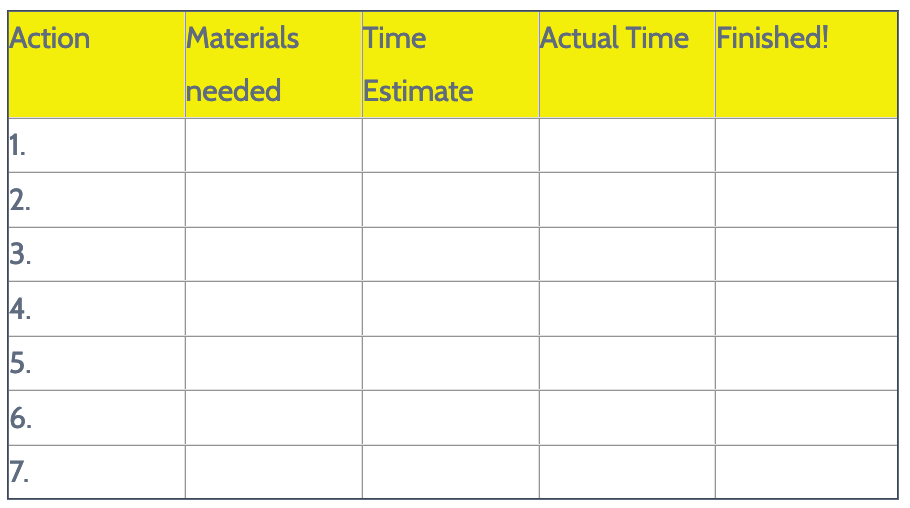 Although many kids and adults with ADHD often reject the structure and practice of this process, I have found that my clients ultimately embrace such programs and find them extremely helpful. These “roadmaps” reduce anxiety, clarify goals and build confidence as activities are completed. So, swallow any resistance and try one today!
Although many kids and adults with ADHD often reject the structure and practice of this process, I have found that my clients ultimately embrace such programs and find them extremely helpful. These “roadmaps” reduce anxiety, clarify goals and build confidence as activities are completed. So, swallow any resistance and try one today!
The Benefits of Working Backwards
 As the days grow shorter and we face turning our clocks back an hour, it seems like a great ‘time’ to talk about the benefits of working backwards in the service of moving forwards. Backwards design means planning in reverse so that you can get to where you want to be in the future. Most people with ADHD have a great deal of trouble managing their time: they are often late, lose track of time or can’t estimate how long a task will take. These problems can be very frustrating to them and to the other people in their lives. The following tips for backwards design can improve time management painlessly and successfully! 1. Stop trying to plan your time from the front end. What this means is that you can’t begin thinking about how to arrive at an event from your current starting point. If it is 6:45 a.m. and you have to leave for school or work until 7:45 a.m., don’t think about how much you can do from now until then. “Oh, I have 30 minutes to get dressed, eat breakfast, brush my teeth, feed the cat and get my backpack (or briefcase) together. I have plenty of time to watch some tv first.” When you think about time in a forward manner, inevitably you underestimate how long things take and then run late. 2. In a calm moment, not in the midst of rushing around but likely afterwards, think about your targeted time for arriving at or departing from an event or completing a task. Then, starting with THAT time, work backwards, assigning increments of time to the various steps that you have to do. If we use the example from Step 1, this would look like: “Ok, I need to leave by 7:45 and before that I have to pack my backpack (or briefcase) which takes about 5 minutes, feed the cat which takes about 5 minutes, brush my teeth which takes about 5 minutes, make and eat breakfast which takes about 15 minutes, get dressed which takes 20 minutes (including my hair and make-up) so that totals 50 minutes. That means that I have 10 extra minutes if I wake up at 6:45. Is that enough? If so, what should I do with those 10 minutes? Do I need those 10 minutes for unpredictable things or returning phone calls or checking my email or Facebook or twitter?” Using backwards design requires an honest assessment of how long tasks actually take, not how long you think they should take.
As the days grow shorter and we face turning our clocks back an hour, it seems like a great ‘time’ to talk about the benefits of working backwards in the service of moving forwards. Backwards design means planning in reverse so that you can get to where you want to be in the future. Most people with ADHD have a great deal of trouble managing their time: they are often late, lose track of time or can’t estimate how long a task will take. These problems can be very frustrating to them and to the other people in their lives. The following tips for backwards design can improve time management painlessly and successfully! 1. Stop trying to plan your time from the front end. What this means is that you can’t begin thinking about how to arrive at an event from your current starting point. If it is 6:45 a.m. and you have to leave for school or work until 7:45 a.m., don’t think about how much you can do from now until then. “Oh, I have 30 minutes to get dressed, eat breakfast, brush my teeth, feed the cat and get my backpack (or briefcase) together. I have plenty of time to watch some tv first.” When you think about time in a forward manner, inevitably you underestimate how long things take and then run late. 2. In a calm moment, not in the midst of rushing around but likely afterwards, think about your targeted time for arriving at or departing from an event or completing a task. Then, starting with THAT time, work backwards, assigning increments of time to the various steps that you have to do. If we use the example from Step 1, this would look like: “Ok, I need to leave by 7:45 and before that I have to pack my backpack (or briefcase) which takes about 5 minutes, feed the cat which takes about 5 minutes, brush my teeth which takes about 5 minutes, make and eat breakfast which takes about 15 minutes, get dressed which takes 20 minutes (including my hair and make-up) so that totals 50 minutes. That means that I have 10 extra minutes if I wake up at 6:45. Is that enough? If so, what should I do with those 10 minutes? Do I need those 10 minutes for unpredictable things or returning phone calls or checking my email or Facebook or twitter?” Using backwards design requires an honest assessment of how long tasks actually take, not how long you think they should take. 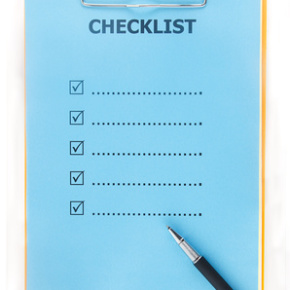 3. Create a list or chart to remind you to use the steps that you have created. Once you have tried this plan, you can alter it in any way that would make it more effective for you. You can also set an alarm on your phone to remind you when you have 5, 10 or 15 minutes to keep you on track. Remember, things often take longer than we anticipate so leave yourself some ‘just in case’ time to deal with the unexpected. When you have succeeded at doing this with one thing in your life, then you can apply it to others such as getting to the dentist’s office on time, arriving at a concert before it starts or showing up for soccer practice when you are supposed to arrive. Being on time (or close to it) can be hard work and yet quite rewarding. Be sure to take pride in your accomplishment or to praise the success of a loved one with ADHD who is trying this. Next week, when you lose an hour to Daylight Saving Time, you can really ‘fall back to spring forward’ as the adage commands by using backwards design!!
3. Create a list or chart to remind you to use the steps that you have created. Once you have tried this plan, you can alter it in any way that would make it more effective for you. You can also set an alarm on your phone to remind you when you have 5, 10 or 15 minutes to keep you on track. Remember, things often take longer than we anticipate so leave yourself some ‘just in case’ time to deal with the unexpected. When you have succeeded at doing this with one thing in your life, then you can apply it to others such as getting to the dentist’s office on time, arriving at a concert before it starts or showing up for soccer practice when you are supposed to arrive. Being on time (or close to it) can be hard work and yet quite rewarding. Be sure to take pride in your accomplishment or to praise the success of a loved one with ADHD who is trying this. Next week, when you lose an hour to Daylight Saving Time, you can really ‘fall back to spring forward’ as the adage commands by using backwards design!!
Talking About the Teenage Brain at Versan Conference in Montego Bay and Kingston, Jamaica
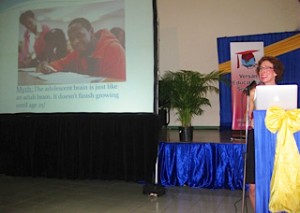 Last month, I had the great privilege to travel to Jamaica to present my talk, “What were you thinking? Understanding the Teen Brain,”at the “Recession-Proofing Your Education” Conferences in Kingston and Montego Bay sponsored by Versan Educational Services. Versan is an international educational organization that advises, places and trains students for boarding schools and colleges around the world. Ms. Sandra Bramwell, the founder and director, is one of the most energetic, eloquent and kind-hearted women whom I have ever met. She is also a visionary. The conferences were attended by over 175 parents, teens and guidance counselors as well as radio stations.
Last month, I had the great privilege to travel to Jamaica to present my talk, “What were you thinking? Understanding the Teen Brain,”at the “Recession-Proofing Your Education” Conferences in Kingston and Montego Bay sponsored by Versan Educational Services. Versan is an international educational organization that advises, places and trains students for boarding schools and colleges around the world. Ms. Sandra Bramwell, the founder and director, is one of the most energetic, eloquent and kind-hearted women whom I have ever met. She is also a visionary. The conferences were attended by over 175 parents, teens and guidance counselors as well as radio stations.
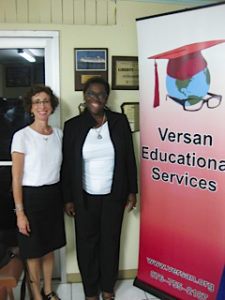
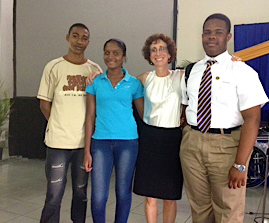 2. Time management: I talked about backwards design, which seemed to be a new concept. We looked at how challenging it can be to get ready and out of the house on time for school in the morning. With the eager participation of one mother and daughter, we traced their morning routine as it unfolds now with all of its bumps and then rearranged it by going backwards from the time of arrival at school. The audience found this technique very useful. I really appreciated the frank feedback that the Jamaicans gave right after my talk—“I liked the part about learning how to make better decisions but not so much about the brain cells”—and their warmth and humor. It was refreshing (and a bit comforting) to see that parents and teens in the Caribbean have many of the same questions and concerns that we have here in the USA.
2. Time management: I talked about backwards design, which seemed to be a new concept. We looked at how challenging it can be to get ready and out of the house on time for school in the morning. With the eager participation of one mother and daughter, we traced their morning routine as it unfolds now with all of its bumps and then rearranged it by going backwards from the time of arrival at school. The audience found this technique very useful. I really appreciated the frank feedback that the Jamaicans gave right after my talk—“I liked the part about learning how to make better decisions but not so much about the brain cells”—and their warmth and humor. It was refreshing (and a bit comforting) to see that parents and teens in the Caribbean have many of the same questions and concerns that we have here in the USA.
Effective Communication – The Rule of Three
 Parents and teachers often complain to me that kids with ADHD don’t remember things they are told. This forgetfulness happens for a number of reasons—poor working memory, internal or external distractions, limited ability to sequence information into steps, anxiety about forgetting—and changing how you talk to a child or teen with ADHD can improve memory. When you are asking someone with ADHD to do something, that request should only have one component. The chances of him or her remembering more than one thing at a time are very slim, even with the aide of medication. So, keep your task SIMPLE. The rule of three is critical to successfully making these changes. 1. Say the youngster’s name. 2. Look directly at him/her AT EYE LEVEL, making sure your gaze is returned and held. 3. State your task clearly and calmly. Ask the child or teen to repeat your request EXACTLY and then, ask for a second repetition. These three steps have to be followed in this sequence in order for them to work most effectively. They activate several ways for connecting—sight, sound, repetition–that trigger different and simultaneous neural pathways. When the single task is completed, then you can give another one in exactly the same manner. Communicating in this easy, direct manner improves the likelihood that the task is remembered and completed. Everyone will be less frustrated and feel more confident that things actually get done!
Parents and teachers often complain to me that kids with ADHD don’t remember things they are told. This forgetfulness happens for a number of reasons—poor working memory, internal or external distractions, limited ability to sequence information into steps, anxiety about forgetting—and changing how you talk to a child or teen with ADHD can improve memory. When you are asking someone with ADHD to do something, that request should only have one component. The chances of him or her remembering more than one thing at a time are very slim, even with the aide of medication. So, keep your task SIMPLE. The rule of three is critical to successfully making these changes. 1. Say the youngster’s name. 2. Look directly at him/her AT EYE LEVEL, making sure your gaze is returned and held. 3. State your task clearly and calmly. Ask the child or teen to repeat your request EXACTLY and then, ask for a second repetition. These three steps have to be followed in this sequence in order for them to work most effectively. They activate several ways for connecting—sight, sound, repetition–that trigger different and simultaneous neural pathways. When the single task is completed, then you can give another one in exactly the same manner. Communicating in this easy, direct manner improves the likelihood that the task is remembered and completed. Everyone will be less frustrated and feel more confident that things actually get done!
